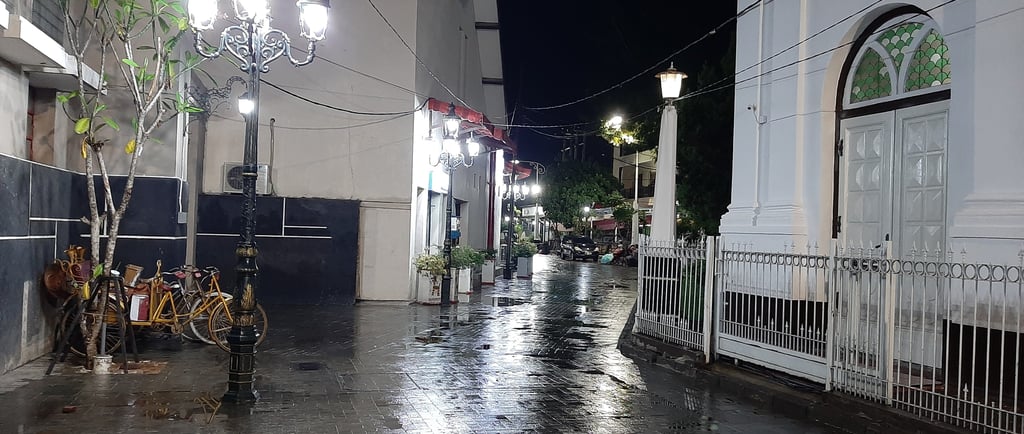Our guides speak English and German, Spanish, Dutch, France, Italian, Russian, Japanese, Arabic on request!
Exploring Kota Tua Semarang: A Journey Through History and Architecture
Kota Tua Semarang, a historical district in Semarang, Indonesia, is a captivating blend of cultural heritage and architectural grandeur. This area, renowned for its colonial-era buildings and charming streets, serves as a testament to the city’s rich past. A stroll through Kota Tua reveals the significant role Semarang played during the Dutch colonial period, making it a focal point for those interested in Indonesia’s historical narrative.
Iwan Kur Kurniawan
12/6/20247 min read


Kota Tua Semarang
The allure of Kota Tua lies not only in its historical significance but also in its architectural beauty. The district showcases various architectural styles, including Dutch, Chinese, and Javanese influences, reflecting the multicultural tapestry of the region. Iconic structures such as the old port, the Lawang Sewu building, and the blend of antique shops and museums add to the district's charm, drawing visitors from far and wide. This vibrant area serves as a living museum of sorts, where one can witness the confluence of different cultures and historical epochs.
Historical Significance
Kota Tua Semarang, established in the 17th century, is a significant testament to the Dutch colonial era in Indonesia. Originally founded by the Dutch East India Company (VOC), this historic district served as a strategic trading post and fort, crucial for the expansion of Dutch influence in the region. The establishment of Kota Tua was largely motivated by the lucrative spice trade, which positioned Semarang as a central hub for commerce between Europe and Asia. The architecture and urban planning of the area are reflective of European styles fused with local influences, illustrating a dynamic period of cultural exchange and adaptation.
The role of Kota Tua as a fortification was pivotal in safeguarding Dutch trade interests against competing colonial powers and local rulers. The remnants of defensive structures and warehouses evoke the bustling activity of a thriving port during the colonial era. Furthermore, the district laid the groundwork for the growth of Semarang, eventually transforming it into one of the major cities in Indonesia. The fusion of various cultures present in Kota Tua, resulting from trade activities, led to a unique societal structure that has significantly shaped the local culture and identity.
Beyond its economic implications, the historical narrative of Kota Tua is interwoven with the struggles of the local populace, as they navigated through colonial rule and the associated socio-political changes. The district not only embodies a rich tapestry of historical events but also serves as a reminder of the complexities of colonialism in Indonesia. Today, Kota Tua stands as a significant cultural heritage site, inviting visitors to explore and reflect upon its multifaceted history and the lasting impacts on contemporary Indonesian society.
Colonial Architecture: A Visual Feast
Kota Tua Semarang, a captivating hub of historical significance, showcases an extraordinary array of colonial architecture. This district is adorned with buildings that speak of the region's rich past, particularly during the Dutch colonial period. One of the most prominent structures within this area is the Blenduk Church, known as Gereja Blenduk. With its distinctive dome and Neoclassical design, this church was constructed in the 18th century and serves as a quintessential example of colonial ecclesiastical architecture. The harmonious blend of brick and plaster in its façade complements its grand interiors, making it a must-visit for those interested in architectural elegance and religious history.
Another iconic site is Lawang Sewu, or "A Thousand Doors." This majestic building originally served as the headquarters for the Dutch East Indies Railway Company. Its name stems from the numerous doors and windows that adorn the structure, enhancing its picturesque quality. The Gothic and Art Deco architectural styles are represented in its design, characterized by high ceilings, expansive hallways, and intricate detailing. Lawang Sewu is imbued with tales of the past, particularly poignant stories from the tumultuous events of World War II, which have transformed it into a popular site for historical exploration.
The Old Town Hall, or Stadhuis, is yet another remarkable piece of colonial architecture in Kota Tua Semarang. Built in the 18th century, this building reflects the neoclassical style preferred by the Dutch colonizers. Its symmetrical design, prominent columns, and beautiful white façade add to the aesthetic appeal of the area. The Old Town Hall has functioned in various capacities throughout its history, including as a courthouse. Together, these structures not only highlight the architectural ingenuity of their time but also serve as a testament to the layered history and cultural narratives inherent in Kota Tua Semarang, inviting visitors to delve deeper into the stories contained within these walls.
Cultural Experience and Local Life
Kota Tua Semarang, a historical enclave, serves not only as a testament to Indonesia's rich colonial past but also as a vibrant hub for contemporary cultural experiences. The juxtaposition of traditional Indonesian customs and colonial architecture creates a unique atmosphere, drawing locals and tourists alike. The area's significance is accentuated during cultural festivals, where the community gathers to celebrate their heritage, showcasing traditional dance performances, music, and craft fairs. These events foster a sense of belonging and pride among residents, reinforcing their connection to the past while adapting to modern influences.
Moreover, local markets play a crucial role in the daily life of Kota Tua Semarang. These bustling centers provide an authentic experience of local culture as vendors offer a myriad of goods ranging from fresh produce to artisanal crafts. The markets are not only places for commerce but also social spaces where residents engage, exchange stories, and uphold traditions. For instance, the annual Semarang Night Carnival exemplifies how local life thrives through vibrant displays of color and activity, creating a festive environment that attracts visitors from all walks of life.
The integration of traditional practices within modern urban life reinforces the community's identity while fostering a sense of continuity amid changes. Traditional street foods, local art, and historic storytelling remain pivotal in everyday interactions. This blend of cultures not only enriches the experience of residing in Kota Tua Semarang but also serves as a window into the diverse tapestry of Indonesian history. Exploring this dynamic area offers insight into how the community navigates its dual heritage, celebrating the rich legacy of both its colonial past and indigenous roots.
Popular Attractions in Kota Tua
Kota Tua Semarang, known for its rich historical significance and well-preserved architecture, offers a range of must-visit attractions that provide an insight into Indonesia’s colonial past. One of the most prominent sites is the Semarang Old Town itself, which boasts a collection of Dutch colonial buildings, museums, and bustling squares. Visitors can expect to admire the stunning architecture while also soaking in the vibrant atmosphere of the area.
Another key attraction is the Fatahillah Museum, housed in the former Stadhuis building. This museum showcases the history of Semarang and its importance during the colonial era. Exhibits include artifacts, replicas, and various displays that narrate the story of the city and its development. Tourists can also enjoy guided tours that delve deeper into the museum’s significance.
The Lawang Sewu, often referred to as the "Thousand Doors," is an iconic landmark in Kota Tua. Originally built as a railway company headquarters, this historical building has become a symbol of the city. The architecture features unique Javanese and Dutch styles, and the site is known for its haunting tales that draw both history enthusiasts and thrill-seekers. Exploring the intricate corridors and expansive rooms reveals not only architectural brilliance but also the stories of the past.
Lastly, the Taman Sari or Water Castle offers visitors a glimpse into the leisure life of the Indonesian nobility. With its pools and fountains, this attraction serves as a beautiful reminder of the past. The serene environment combined with its historical relevance makes it a delightful place to visit. As you stroll through Kota Tua Semarang, you will find these attractions enriching, engaging, and highlighted by the city’s storied heritage.
Preservation Efforts and Challenges
The historic district of Kota Tua Semarang, known for its rich architectural heritage and cultural landmarks, faces both significant preservation efforts and substantial challenges. Local authorities, such as the Semarang City Government, along with various non-governmental organizations, have embarked on initiatives aimed at restoring and maintaining the integrity of these historical sites. This involves not only physical rehabilitation of the buildings but also the implementation of policies that facilitate sustainable tourism while safeguarding the district's unique identity.
One of the major efforts includes the restoration of iconic structures like the Blenduk Church and the Lawang Sewu building. These projects often involve collaboration with architects, historians, and conservation specialists who ensure that the restoration process adheres to the original architectural styles and materials. Furthermore, community engagement plays a pivotal role, as local residents are often included in the planning processes and educated about the importance of preserving their cultural heritage.
However, these preservation efforts face numerous challenges. One prominent issue is the balance between tourism development and the protection of historical integrity. With increasing tourist interest, there is a risk of commercialization, which may compromise the authenticity of the area. Local authorities must navigate these tensions carefully to ensure that tourism does not lead to the degradation of cultural landmarks.
Another challenge is the financial constraints that hinder comprehensive restoration projects. The costs associated with preservation are often overwhelming for local governments, necessitating alternative funding sources, such as public-private partnerships and donations from heritage organizations. Such financial strategies are vital to ensure that Kota Tua Semarang can thrive as a historical site while welcoming visitors who wish to explore its past.
Visiting Tips for Tourists
When planning a visit to Kota Tua Semarang, timing can significantly enhance your experience. The ideal months to explore this historical gem are during the dry season, which typically runs from April to October. During this period, the weather is more favorable, allowing tourists to comfortably stroll along the cobblestone streets and appreciate the stunning colonial architecture without the hindrance of rain. Aim to visit early in the morning or late afternoon to avoid the midday heat and enjoy the best lighting for photography.
Transportation options to Kota Tua Semarang are varied and cater to different preferences. For ease of access, taxis and ride-sharing services are readily available and provide a convenient way to reach the area. If you prefer a more local experience, consider using public transportation, such as the Trans Semarang bus service, which is affordable and well-connected to key landmarks. Once in the area, walking is the most recommended way to navigate Kota Tua, as many attractions are within a short distance from each other. This allows you to soak in the ambiance and discover hidden pockets of history.
While exploring Kota Tua Semarang, indulging in local cuisine is a must. Do not miss out on trying Tahu Gimbal, a fried tofu dish served with a peanut sauce, or Semarang's famous lumpia, a spring roll filled with bamboo shoots and shrimp. Street food stalls and local eateries scattered throughout the area offer a variety of authentic flavors that truly reflect the cultural heritage of Semarang.
Lastly, take your time to appreciate the unique blend of history and culture in Kota Tua. Engage with local vendors, visit small museums, and enjoy the vibrant street art. By immersing yourself in the atmosphere, you can gain a deeper understanding of this historic site, making your visit not only enjoyable but also enriching.






